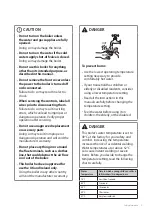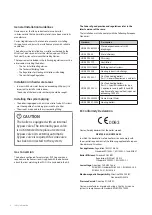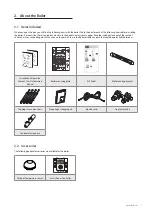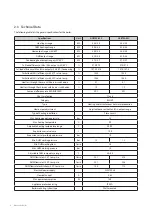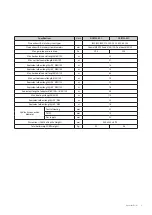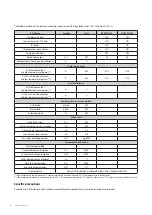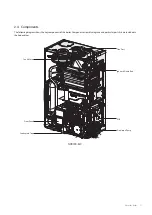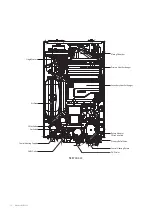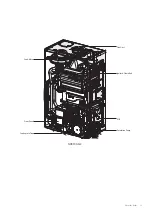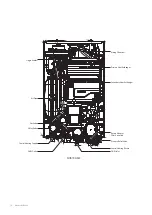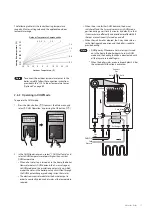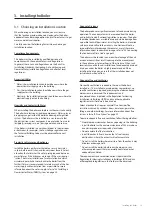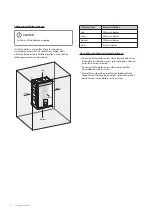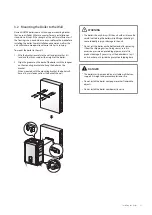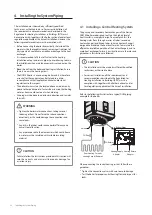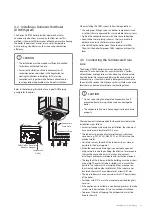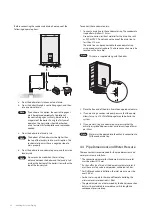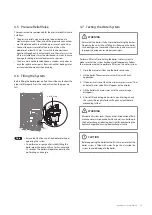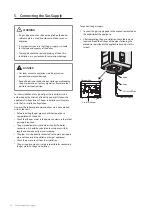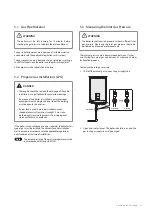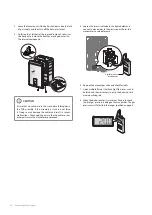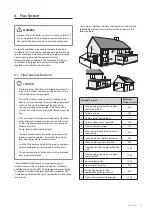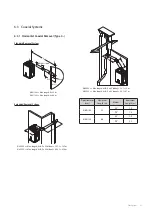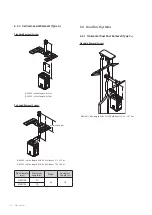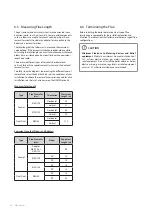
Installing the Boiler 19
3.1 Choosing an Installation Location
When choosing an installation location, you must ensure
that the location provides adequate clearance for the boiler,
adequate flue and drainage options, and sufficient access to gas,
water, and electrical supplies.
Carefully consider the following factors when choosing an
installation location:
Compliance Requirements
This boiler must be installed by qualified personnel in
compliance with the applicable Laws and Regulations.
In general, these Laws and Regulations are the Basic Gas
Installation Standards, the Heating, Air Conditioning and
Domestic Water Installation Regulation and all other local
regulations.
Access to Utilities
●
Water–the installation location should be near where the
domestic water supply enters the building.
●
Gas–the installation location should be near where the gas
supply enters the building.
●
Electricity–the installation location should be near where the
electrical supply enters the building.
Humidity and Contact with Water
When installing the boiler, avoid places with excessive humidity.
The boiler has electric gas ignition components. Water spray or
droppings can get inside the boiler and damage the ignition
system. The boiler must be installed in a way to ensure that
the gas ignition system components are protected from water
(dripping, spraying, rain, etc.) during operation and service.
If the boiler is installed in a very humid room (a shower room
or bathroom, for example), the Low Voltage regulation and
the Technical Building Code must be observed for correct
installation.
Proximity to Fixtures and Appliances
Install the boiler near fixtures that deliver or use hot water,
such as bathroom, kitchen, and laundry room faucets. Select
a location that minimises the water piping required between
major fixtures. If the distances are long or if the user requires
“instant“ hot water, installation of a recirculation line which
circulates domestic hot water back to the boiler from the
furthest fixture is recommended. Insulate as much of the hot
water supply and recirculation lines as possible. For more
information about the water supply, refer to "4.2 Installing a
Domestic Hot Water (DHW) System” on page 23.
Adequate Drainage
The boiler produces a significant amount of condensate during
operation. This condensate must be removed from the boiler,
and suitably treated if national legislation so requires. The boiler
should be located near a suitable drain and where damage from
a possible leak will be minimal. Installing the boiler in a location
without a drain will void the warranty and Navien will not be
responsible for water damage that occur as a result. For more
information about condensate drainage, refer to “4.3 Connecting
the Condensate Drain Line” on page 23.
The boiler must be located in an area where leakage of the unit
or connections will not result in damage to the area adjacent
to the appliance or to lower floors of the structure. When such
locations cannot be found, installation of an adequately drained
drain pan under the boiler is highly recommended. When
installing the drain pan, ensure that the installation does not
restrict combustion air flow.
Adequate Flue and Ventilation
No specific ventilation is required in the room the boiler is
installed in. If it is installed in a cupboard or compartment, no
specific ventilation is required, providing the aforementioned
dimensions are observed. The requirements and
recommendations stipulated in the Regulation for Heating
Installations in Buildings (RITE) and any other applicable
legislation in this field must be observed.
Select a location that requires minimal flue. Consider flue
restrictions caused by windows, doors, air intakes, gas meters,
foliage, and other buildings. For more information about flue
system, refer to “6. Flue System” on page 29.
To ensure adequate flue and ventilation, follow these guidelines:
●
Maintain proper clearances from any openings in the building.
●
Install the boiler with a minimum clearance of 300 mm above
an exterior grade or as required by local codes.
●
Do not enclose the flue termination.
●
Install the exhaust flue in an area that is free from any
obstructions, where the exhaust will not accumulate.
●
Do not install the boiler where moisture from the exhaust may
discolour or damage walls.
●
Do not install the boiler in bathrooms, bedrooms, or any
other occupied rooms that are normally kept closed or not
adequately ventilated.
The requirements and recommendations stipulated in the
Regulation for Heating Installations in Buildings (RITE) and any
other applicable legislation in this field must be observed.
3. Installing the Boiler
Содержание NCB700-42C
Страница 69: ...68 Appendices 12 4 Ladder Diagram 3 15A...
Страница 73: ...Memo...
Страница 74: ...Memo...
Страница 75: ...Memo...

